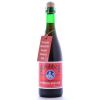Brouwerij Strubbe - Strubbe’s Grand Cru
-
ABV:
6.5% -
Serving Temperature:
50–57° F -
Suggested Glassware:
Tulip, Snifter, Flute
We tend to be a little reserved when it comes to Flemish red ales, if only because that sweet-and-sour composition occasionally veers into a less-appetizing territory: with stale sweetness, overripe fruits, and just a muddled texture overall. This beer is nothing like that, and instead keeps a bright red fruitiness and an effervescence at the very front of things. We dig this one, a whole lot, in that it keeps that developed and velvety depth of the style (which, in the case of Strubbe’s, spends two years aging in Bordeaux oak barrels), yet still maintains a freshness and vibrancy in the palate that keeps us invested, that feels as bright as new American sours.
If we were given four words to describe this beer, we’d say “fruit fruit fruit yum.” Thinking a bit more carefully about our answer, perhaps, we’d add descriptors for leather, or tartness, or caramel. But always at the core is that deep fruitiness: cherries, blackberries, strawberries. It’s a constant lifting presence throughout, and especially intricate for a beer containing no fruit.
Strubbe’s Grand Cru pours a deep golden-brown color, almost like mahogany. A reasonable clarity, and a touch viscous. An off-white chain of bubbles lingers along the perimeter of the glass, stringing very light lacing behind it. This has that look of aged wood, like the colors of liquid barrel. That central, bright berry character emerges from the glass first, followed right behind by rounded notes of fruit leather and caramel, with just a very light oxidation present. Those fruit qualities seem to just spill out once this warms up: cherries and strawberries, and blackberries, again, as well as ripe pear, even a bit of apple cider. There’s no alcohol apparent in the nose, at least, and the approach of this is just generous and layered and fruit forward.
While a number of our recent selections have benefited quite a bit from being allowed to get up to the proper serving temperature, the Strubbe’s Grand Cru seemed to be excellent at just about all of them. On the palate, that ripe and layered fruitiness leads, offering a similar level of complexity to the berry notes of the nose, with a smooth, velvety texture just bringing all the other flavors along behind it: raisins, honey, rich caramel, candied fruits (the fruitiness is, effectively, boundless), tart lemony citrus, and softer notes of pear and tannic toastiness near the finish. Between the outward carbonation and the firm acidity, nothing feels heavy or the slightest bit palate fatiguing. The CO2 scrubs the tongue, the tartness is like little jolts, and an exceptional balance is struck between fresh mouthfeel and the years that went into this beer.
Bottles of Strubbe’s Grand Cru should age fine for some time, although, as the label puts it, “keep cold and in [a] dark space.” We think its balance is exceptional already, and do keep in mind that this already has at least two years behind its belt already. A natural pairing for this would be roasted pork tenderloin, that red fruit and caramelized richness matching perfectly.
Brouwerij Strubbe, while a new inclusion for us at The Rare Beer Club™, is hardly new itself. A certain Carolus Strubbe departed the West Flanders town of Tielt for nearby Ichtegem back (way back) in 1830, establishing a new life for himself as a farmer and brewer. As was typical of so many small operations at that time, the farm grew its own brewing ingredients on site. The brewery records their founder’s history as follows: “In summer, [Strubbe] tilled the land, and in winter he worked on the malt floor with his stirring barrel.” A different time entirely.
Fast-forward through six generations of the Strubbe family’s ownership: from Carolus to his son Louis, to Louis’ son Medard (who formalized the brewery’s name to Brouwerij Strubbe), and so on down the line. Today Norbert Strubbe (Carolus’ great-great-great grandsomething, if our math’s right) handles the business, while Marc Strubbe (ditto) steers the brewing. This is one of the Belgian breweries that survived, and despite the fact the country once had over 3,000 breweries at the start of the 1900s. While increasing, there are now just a few hundred.
Like many long-lasting breweries, Brouwerij Strubbe has explored a significant range of beer styles over the years, from their “simple” and “high fermentation” beers (2% and 4% ABV, respectively) early on, to things like bocks and pilsners and, eventually, something called their “Bruin Hengstenbier,” which they approximately translate as “brown stallion beer.” This was both sweet and sour, and it was beloved by customers when the other styles were stalling. In 1982, it became the base beer for Ichtegem’s Oud Bruin. And the rest (as thus far) is history.
Today, Brouwerij Strubbe covers significant turf, ranging from IPAs to a traditional blending of lambics. Having been privy to numerous Strubbe examples over the years, the Grand Cru remains the one we keep avidly returning to. It’s born of that same brown-stallion-beer line: an exceptional blend of sweet-sour components, unfolding as an exquisite red ale that speaks volumes about what Flemish reds can be: effortlessly intricate, slowly conditioned by time.
Strubbe’s Grand Cru sees very modest distribution in the U.S., so we’re excited to bring this to our members of The Rare Beer Club™. Amidst the sea of mouth-puckering-to-the-point-of-implosion American sours, this serves as a reminder of what we truly appreciate seeing from these kinds of beers, with its layers of yeast-driven complexity and a pitch-perfect mouthfeel.

Unmatched Variety by style, brewery & country
Choose from Five different Beer Clubs offering unmatched variety by brewery,
country of origin, and beer style to suit your specific tastes.


